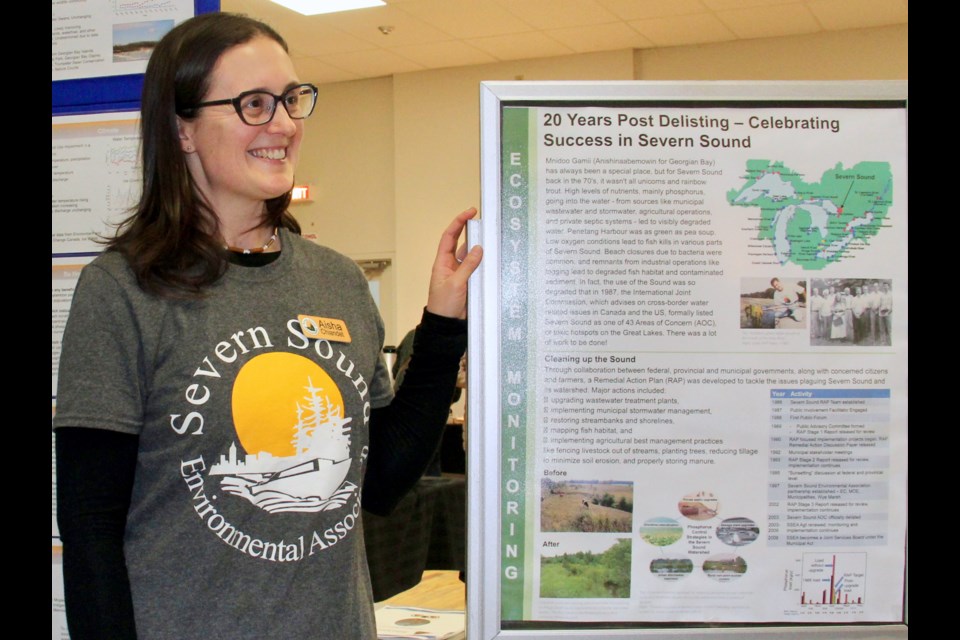How is Severn Sound doing?
This key question about the health of local waters will be answered later this summer when a major report is released by the Severn Sound Environment Association (SSEA).
It will be the first comprehensive report released since southeast Georgian Bay was delisted as an area of concern in 2003 after having been listed as an area of concern under the Canada-U.S. Great Lakes Water Quality Agreement in 1987.
"We were once one of the most polluted areas on the Great Lakes," says Julie Cayley, executive director of the SSEA.
The SSEA was formed in 1997 as a partnership between all three levels of government including the surrounding eight municipalities to complete the Severn Sound Remedial Action Plan to stop pollution and clean up the water.
After years of work - to reduce phosphorus from municipal sewage treatment plants, private septic systems, improved farm management practices and greater protection and restoration of wetlands and watersheds - the watershed was delisted.
"Working with the community and the municipalities and the farmers we get de-listed as an area of concern - that's the biggest success for this organization," Cayley says.
However, there are significant challenges to keeping it that way.
Melissa Carruthers, manager of source water protection for the SSEA, said challenges include "a lot of population growth and aging infrastructure in this area."
Carruthers works with municipal partners to make sure drinking water meets the standards of the Ontario Clean Water Act, passed in 2006.
"The main purpose is to protect municipal drinking water from overuse and contamination," she says.
That includes the municipalities of Georgian Bay, Springwater, Oro-Medonte, Severn, Tay and Tiny townships and the towns of Midland and Penetanguishene.
Another challenge is the increasing occurrence of algal blooms, according to Cayley.
“There’s been a lot more algae blooms happening and they are happening sooner and lasting longer. And those can be dangerous if its toxic blue-green algae."
There have been toxic blue-green algal blooms in Georgian Bay, Farlain and Orr lakes.
Cayley and her team are working with the townships, cottagers and land owners to see what they can do to have a healthier shoreline.
Water scientist Aisha Chiandet is one of three authors on the health of Severn Sound study that has been compiling scientific data from at least a dozen sources. A draft of the 220-page report is done and they are working on a final report. A reader-friendly synopsis will also released with the main report later this summer.
"We have 18 different indicators we use - everything from quality of the sediment and water to algae, zooplankton, fish and invasive species," she says. The one-year project also consulted local First Nation and Métis and good partnerships have developed, Chiandet adds.
"It feels very satisfying to take a longer perspective because we are often asked 'How is Severn Sound doing? We've been at this for a long time so to be able to report results feels like it will be beneficial to the community."
On the terrestrial side, there are two tree planting programs. The tree seedling distribution program allows landowners to purchase seedlings of coniferous and deciduous species and plant them on their own properties. In 2023, the SSEA sold and planted 14,700 trees.
There is also a community planting program using volunteers, including children from Scouts Canada, to plant trees on private land for landowners who want to create or expand their forest. Last year 4,000 trees were planted.
"It's really rewarding to work with the landowners as well as the volunteers, especially the younger kids," said Travis van Engelen, the tree planting specialist for SSEA.
Trees take carbon out the atmosphere year by year as they grow and provide wildlife habitat.
"An objective of our program is to connect existing forests to make a wildlife corridor," van Engelen says.
Cayley said there is several other projects happening at the SSEA.
Jonathan Main is heading up work on the Climate Action Plan. Most municipalities are on board, recording emissions and developing a plan to reduce them as well as building resilience into systems to buffer severe weather effects that climate change brings.
Georgian Bay, Little Lake and Bass Lake will be scientifically monitored this summer.
"There is a lot of work going on with a small but mighty team." There are seven permanent and five contract employees at SSEA.
“This is the most amazing group of people I’ve ever worked with," says Cayley. "They are dedicated. They are brilliant. Their energy is unlimited and they are great visionaries. They are great people to have working for us protecting our water and our future.”
To volunteer for tree planting, email van Engelen at [email protected].



